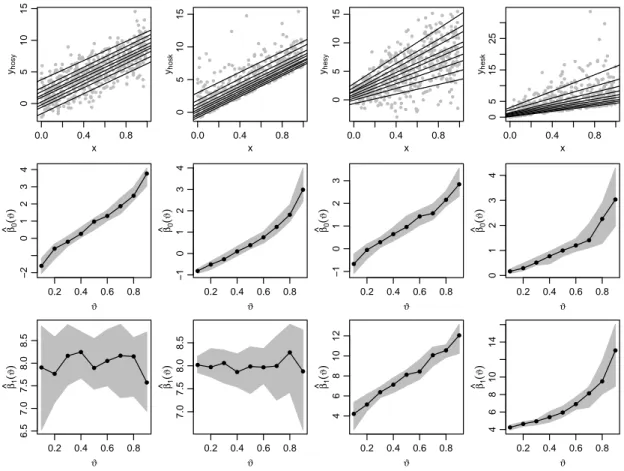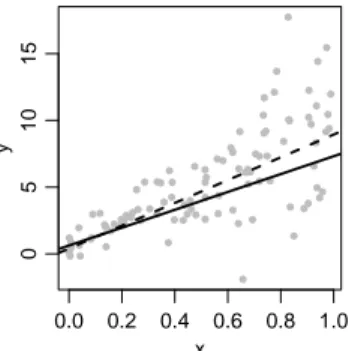Spline-based model specification and prediction for least squares and
quantile regression
Dissertation zur Erlangung des Grades eines Doktors der Wirtschaftswissenschaft
eingereicht an der Wirtschaftswissenschaftlichen Fakult¨ at der Universit¨ at Regensburg
vorgelegt von: Kathrin Kagerer
Berichterstatter:
Prof. Dr. Rolf Tschernig, Universit¨ at Regensburg Prof. Dr. Harry Haupt, Universit¨ at Bielefeld
Tag der Disputation: 16. M¨ arz 2012
Contents
List of Figures iii
List of Tables v
1 Introduction and overview 1
1.1 Introduction and methodological background . . . 1
1.1.1 Classical linear least squares regression analysis . . . 2
1.1.2 Splines . . . 3
1.1.3 Quantile regression . . . 21
1.1.4 Computational aspects . . . 33
1.2 Outline of the projects . . . 34
1.2.1 Beyond mean estimates of price and promotional effects in scanner-panel sales-response regression . . . 34
1.2.2 Using quantile regression to predict brand sales from retail scan- ner data . . . 35
1.2.3 Cross-validating fit and predictive accuracy of nonlinear quantile regressions . . . 37
1.2.4 Out-of-sample predictions for penalized splines . . . 38 2 Beyond mean estimates of price and promotional effects in scanner-
panel sales-response regression 41
3 Smooth quantile based modeling of brand sales, price and promotional
effects from retail scanner panels 43
4 Cross-validating fit and predictive accuracy of nonlinear quantile re-
gressions 45
5 Out-of-Sample Prediction for Penalized Splines 47
5.1 Introduction . . . 48
5.2 Splines and their hat matrix . . . 49
5.2.1 Splines with penalties and monotonicity constraints . . . 49
5.2.2 A hat matrix for monotonicity constrained P-splines . . . 52
5.3 Predictions using splines . . . 53
5.4 Monte Carlo simulation . . . 55
5.4.1 Data generating processes . . . 55
5.4.2 Simulation results . . . 56
5.5 Empirical examples . . . 62
5.5.1 Motorcycle acceleration . . . 63
5.5.2 LIDAR . . . 63
5.6 Extensions . . . 65
5.6.1 Larger prediction horizons . . . 65
5.6.2 Predictions with minimal penalty . . . 66
5.6.3 Re-locate boundary knot . . . 68
5.6.4 Kernel estimation . . . 70
5.7 Conclusion . . . 71
Bibliography 73
List of Figures
1.1 Different bases and examples for linear combinations of the basis func- tions. . . 5 1.2 B-spline bases, sums and linear combinations for different ordersk with
equidistant knots. . . 8 1.3 B-spline bases, sums and linear combinations for different ordersk with
equidistant knots where one knot position is multiple occupied. . . 10 1.4 B-spline basis functions of different orderskwith non-equidistant knots
and their sum. . . 11 1.5 Monotonically weighted B-spline basis functions and their first derivative. 13 1.6 Apart from one time monotonically weighted B-spline basis functions
and their first derivative. . . 13 1.7 Loss functions for least squares estimation and quantile regressions. . . 23 1.8 Results from quantile regressions for simulated data. . . 24 1.9 Scatter plot with estimated quadratic quantile regression curves and
estimated parameters for simulated data. . . 25 1.10 Conditional ϑ-quantiles for heteroskedastic logistic error distribution. . 27 1.11 Scatter plot with crossing estimated quantile regression lines for simu-
lated data. . . 31 5.1 Cubic B-spline basis functions for equidistant knot sequence and one
additional basis function. . . 50 5.2 Plot of knot positions versus estimated spline parameters for the mo-
torcycle data. . . 54 5.3 Function f1(x) and ASEP results from the simulation. . . 59
5.4 Function f2(x) and ASEP results from the simulation. . . 59
5.5 Function f3(x) and ASEP results from the simulation. . . 60
5.6 Function f4(x) and ASEP results from the simulation. . . 60
5.7 Function f5(x) and ASEP results from the simulation. . . 61
5.8 Function f6(x) and ASEP results from the simulation. . . 61
5.9 Motorcycle data example and ASEP results for predictions to the right. 64 5.10 Motorcycle data example and ASEP results for predictions to the left. 64 5.11 LIDAR example and ASEP results. . . 65
5.12 Average ASEP results for f1(x) and a 1-, . . ., 6-intervals horizon. . . . 67
5.13 Average ASEP results for f2(x) and a 1-, . . ., 6-intervals horizon. . . . 67
5.14 Average ASEP results for f3(x) and a 1-, . . ., 6-intervals horizon. . . . 68
5.15 Average ASEP results for f4(x) and a 1-, . . ., 6-intervals horizon. . . . 68
5.16 Average ASEP results for f5(x) and a 1-, . . ., 6-intervals horizon. . . . 69
5.17 Average ASEP results for f6(x) and a 1-, . . ., 6-intervals horizon. . . . 69
List of Tables
5.1 Classification and summary of prediction methods. . . 55 5.2 Share ofRreplications where the prediction method with lowest ASEP
for knot interval Im is the same as the method with lowest ASEP for the majority of knot intervals It, t = s, . . . ,m−1, and share of R×(m−s)cases where the prediction method with lowest ASEPfor knot interval It, t =s+1, . . . ,m, is the same as for knot interval It−1. 62
1 Introduction and overview
1.1 Introduction and methodological background
Systema [. . .] maxime probabile valorum incognitarum [. . .] id erit, in quo quadrata differentiarum inter [. . .] valores observatos et computatos sum- mam minimam efficiunt.
[. . .] that will be the most probable system of values of the unknown quantities [. . .] in which the sum of the squares of the differences between the observed and computed values [. . .] is a minimum.
This insight still is of crucial interest more than 200 years after Carl Friedrich Gauss stated it in 1809 (Gauss, 1809, p. 245, translation from Davis, 1857, p. 260). The method of least squares is historically used to describe the course of planets by Gauss (1809) and Legendre (1805) who independently suggested the same method. Today there are many more fields that apply the method of least squares in regression analysis.
Among these are geography, biology/medicine and economics.
Years before Gauss’ and Legendre’s method of least squares, Laplace suggested to minimize the sum of absolute differences between observed and calculated observations (Laplace, 1789). Portnoy & Koenker (1997) provide a historical review and a detailed comparison of both methods. Minimizing the sum of absolute differences, as introduced by Laplace, is a special case of the method which is nowadays known as quantile regression.
1.1.1 Classical linear least squares regression analysis
Classical linear least squares regression can be applied to quantify the change of the expected outcome of the response y given x1 and potential other factors x2, . . . ,xq
when x1 varies by some amount while the other covariates x2, . . . ,xq are held fixed.
Accordingly, the expected value of y given the covariates x1, . . . ,xq, E(y|x1, . . . ,xq), is a function of the covariates, that is, it can be expressed as
E(y|x1, . . . ,xq) = f(x1, . . . ,xq), (1.1)
where f is a (unknown) function that describes the relationship between E(y|x1, . . . ,xq) and the covariates x1, . . . ,xq. Hence, the relationship between y and f(x1, . . . ,xq) is given by
y = f(x1, . . . ,xq) +u, (1.2)
where E(u|x1, . . . ,xq) =0.
An often applied choice when estimating the function f, is to assume a linear rela- tionship between E(y|x1, . . . ,xq)and the covariatesx1, . . . ,xq. That is, the functional form f is a linear combination of the covariates,
f(x1, . . . ,xq) = β0+β1x1+. . .+βqxq, (1.3)
where β0, . . . ,βq are unknown parameters that need to be estimated. For a given sample i =1, . . . ,n the parameters may be estimated by solving
˜ min
β0,..., ˜βq∈R
∑
n i=1yi−(β˜0+β˜1x1+. . .+β˜qxq)2.
Hence, the estimates for the parameters β0, . . . ,βq are those that minimize the sum of squared differences between the observed values yi and the computed values yˆi = βˆ0+βˆ1xi1+. . .+βˆqxiq. That is, the parameters are estimated by applying Gauss’
method of least squares.
To allow for other functional forms, E(y|x1, . . . ,xq)could, for example, be expressed as linear combination of higher order polynomials or other transformations of the co- variates. This implies a possibly extensive specification search for f. To avoid this,
non- or semiparametric specifications for f can be applied. Spline regression is one of these nonparametric methods. An outline of splines and spline regression is given in Section 1.1.2.
For simplification, consider a bivariate relationship between one covariate x and the response y. Then, Equation (1.1) simplifies to
E(y|x) = f(x). (1.4)
If f is incorrectly specified for the estimation, several conclusions (e.g. interpretations of marginal effects and hypothesis tests) that build on a correctly specified model are invalid. Hence, a correct specification of f is crucial.
1.1.2 Splines
Basis functions
Truncated power basis and splines Piecewise polynomial functions constitute an easy approach to adopt a flexible functional form without being demanding to im- plement. These functions can be generated in different ways. An intuitive way to understand the main principle is to consider the truncated power basis (see for ex- ample Ruppert et al., 2003, ch. 3, Dierckx, 1993, ch. 1.1, de Boor, 2001, ch. VIII as general references). Consider a straight line on some interval [κ0,κm+1] (e.g.
[κ0,κm+1] = [mini(xi), maxi(xi)] for a sample i = 1, . . . ,n) with a kink at some position κ1 where κ0 < κ1 < κm+1. It can be described by a weighted sum (i.e. a linear combination) of the basis functions 1, x and (x−κ1)+, where the truncation function
(x−κ1)+ =
x−κ1 for x ≥κ1
0 else
gives the positive part of x−κ1. The reasoning for the basis functions 1, x and (x−κ1)+ is as follows: To obtain a straight line f that is folded atκ1 but continuous there, this function f can be written as β0+β1x forx <κ1and as β00+ (β1+α1)x for x ≥ κ1. That means, the slope is β1 until x = κ1 and from x = κ1 on the
slope is changed by α1. As f is constrained to be continuous at κ1, this requires β0+β1κ1 = β00+ (β1+α1)κ1 to hold or equivalently β00 = β0−α1κ1. Overall, f then is given by
f(x) = (β0+β1x)·I{x<κ1}+ β00+ (β1+α1)x
·I{x≥κ1}
= (β0+β1x)·I{x<κ1}+ (β0+β1x+α1(x−κ1))·I{x≥κ1}
=β0+β1x+α1(x−κ1)I{x≥κ1}
=β0+β1x+α1(x−κ1)+
where I{A} is the indicator function which is 1 if A holds and 0 else. That is, f can be written as a linear combination of the basis functions 1, x and (x−κ1)+.
Note that linear least squares regression with a constant and one covariatexhas the two basis functions 1 and x and that for example an additional quadratic term leads to the additional basis function x2.
Analogously to the line folded only at κ1, a line folded m times at the positions κ1, . . . ,κm can be written as the weighted sum of the basis functions 1, x, (x− κ1)+, . . . ,(x−κm)+, where the κj’s are called knots. With a proper choice of the knotsκj, the functions generated from this basis can approximate other functions rather well. However, it yields a curve with sharp kinks that is not differentiable at the knots.
These sharp kinks as well as the lacking differentiability are often undesirable. Smoother curves can be obtained by using higher powers of the basis functions. The respective basis of degree p≥0consists of the functions1,x, . . . ,xp,(x−κ1)+p, . . . ,(x−κm)+p, where (x−κj)p+ := (x−κj)+p
and 00 := 0, and is called truncated power basis of degree p. The truncated power function (x−κj)+p is (p−1)-times continuously differentiable atκj. Hence, also the linear combinations (called splines, Ruppert et al., 2003, p. 62) of the truncated power basis functions are (p−1)-times continuously differentiable at the knots κj, j =1, . . . ,m.
Additionally including lower powers (< p) of (x−κj)+ in the basis, changes the differentiability properties. That is, if the basis consists for example of the functions 1,x, . . . ,xp,(x−κ1)+p, . . . ,(x−κ1)+p−m1+1,(x−κ2)+p, . . . ,(x−κm)p+, the resulting linear combinations are (p−m1)-times continuously differentiable atκ1 and (p−1)- times continuously differentiable atκ2, . . . ,κm, where m1can be regarded as multiplic-
ity of the knotκ1(e.g. Eubank, 1984, p. 447f.). Formj = p+1, functions constructed as linear combination from the truncated power basis functions of degree phave a dis- continuity/jump atκj. Ifmj >1, the respective knots and basis functions are denoted as(x−κj)+p, . . . ,(x−κj+mj−1)p+−m1+1, whereκj =. . .=κj−mj+1. That is, the knot κj has multiplicity mj (and so have κj+1, . . . ,κj−mj+1 where mj = . . . = mj−mj+1).
This notation is consistent with the notation for the equivalent B-spline basis which is described later on. Further, the truncated power basis of degree pthus always consists of p+1+m basis functions that are identified once the knot sequence is given.
The panels in the upper row of Figure 1.1 show the functions of the above described bases: the basis for linear functions (1, x), the basis for cubic functions (1,x, x2, x3), the truncated power basis of degree 1 with one knot at 0.4 (1, x, (x−0.4)+), the truncated power basis of degree 1 with four knots at0.2, . . ., 0.8 (1, x, (x−0.2)+, . . ., (x−0.8)+) and the truncated power basis of degree 3 with four knots at 0.2, . . .,0.8 (1, x, x2, x3, (x−0.2)3+,. . .,(x−0.8)3+). Additionally, the lower row shows an arbitrary example for a linear combination of the basis functions for each of the illustrated bases.
0.0 0.2 0.4 0.6 0.8 1.0
0.00.20.40.60.81.0
x
0.0 0.2 0.4 0.6 0.8 1.0 x
0.0 0.2 0.4 0.6 0.8 1.0
0.00.20.40.60.81.0
x
0.0 0.2 0.4 0.6 0.8 1.0 x
0.0 0.2 0.4 0.6 0.8 1.0
0.00.20.40.60.81.0
x
κ1
0.0 0.2 0.4 0.6 0.8 1.0
κ1x
●
0.0 0.2 0.4 0.6 0.8 1.0
0.00.20.40.60.81.0
x
κ1 κ2 κ3 κ4
0.0 0.2 0.4 0.6 0.8 1.0
κ1 κ2xκ3 κ4
●
●
●
●
0.0 0.2 0.4 0.6 0.8 1.0
0.00.20.40.60.81.0
x
κ1 κ2 κ3 κ4
0.0 0.2 0.4 0.6 0.8 1.0
κ1 κ2xκ3 κ4
● ● ●
●
Figure 1.1: Top: different bases (from the left): basis functions for straight line, for cubic polynomial, for straight line with one kink, for straight line with four kinks, for cubic poly- nomial with four kinks. Bottom: arbitrary examples for linear combinations of the basis functions from the corresponding upper panel.
A disadvantage of the truncated power basis is that the basis functions are correlated and hence estimation results are often numerically instable (Ruppert et al., 2003, p. 70).
An equivalent basis that does not have this problem (Dierckx, 1993, p. 5, Ruppert et al., 2003, p. 70, de Boor, 2001, p. 85f.) and leads (apart from computational accuracy) to the same fit on [κ0,κm+1] (Ruppert et al., 2003, p. 70) is the B-spline basis of order k = p+1 ≥1 where p is the degree of the truncated power basis. In the following, B-splines are introduced.
B-spline basis and splines In a nutshell, the functions from the B-spline basis are piecewise polynomial functions of order k that are connected at the knots and have only small support. Then the spline of order k, which is a linear combination of the basis functions, is also a piecewise polynomial function of orderk. It exhibits the same properties as the respective linear combination of the functions from the truncated power basis of degree p = k−1 with the same knots κ1, . . . ,κm. A short review concerning B-splines can be found e.g. in the work of Eilers & Marx (1996) who summarize the definition and properties of B-splines while de Boor (2001), Dierckx (1993) and Ruppert et al. (2003) provide a more extensive discussion of splines.
To derive the B-spline basis of order k, some definitions are necessary. Let κ = (κ−(k−1), . . . ,κm+k) be a non-decreasing sequence of knots (i.e. κ−(k−1) ≤ . . . ≤ κm+k), where at most k adjacent knots coincide (i.e. κj 6= κj+k). The two bound- ary knots κ0 and κm+1 define the interval of interest and the m knots κ1, . . . ,κm
are called inner knots. The remaining 2(k−1) exterior knots κ−(k−1), . . . ,κ−1 and κm+2, . . . ,κm+kare required to ensure regular behavior on the interval[κ0,κm+1]. The B-spline basis functions (also called B-splines) are denoted asBκ,kj ,j =−(k−1), . . . ,m.
B-splines can be motivated in different ways. One of them is to derive them by using divided differences (for a definition of divided differences and the corresponding representation of B-splines see for example de Boor, 2001, p. 3, 87). Another way that does not involve the definition of divided differences and can be shown to lead to the same result (cf. de Boor, 2001, p. 88) is to recursively calculate the B-splines of order k > 1 from the B-splines of lower order using the recurrence relation from de Boor (2001, p. 90)
Bκ,kj (x) = x−κj κj+k−1−κjB
κ,k−1
j (x) − x−κj+k
κj+k−κj+1B
κ,k−1 j+1 (x),
where
Bκ,1j (x) = (κj+1−x)0+−(κj−x)0+ =
1 for κj ≤x <κj+1
0 else
is the B-spline of order1(de Boor, 2001, p. 89) and the indexj runs from−(k−1) to m. To obtain the properties of B-splines on the complete interval [κ0,κm+1] but not only on[κ0,κm+1), the definition ofBmκ,1 and Bκ,1m+1is modified such that Bκ,1m (x) = 1 for x=κm+1 and Bmκ,1+1(x) = 0 for x=κm+1 (cf. de Boor, 2001, p. 94).
For equidistant knots, that is ∆κj =κj−κj−1=: h for j=−(k−1) +1, . . . ,m+ k, it can be shown (based on an extension of Problem 2 from de Boor, 2001, p. 106) that the function Bκ,kj can also be written as
Bκ,kj (x) = 1
hk−1(k−1)! ∆
k(κj+k−x)k+−1
where∆k :=∆(∆k−1).
Figure 1.2 gives examples for B-spline bases of different orders k for an equidistant knot sequence κ with m = 3 inner knots. In the first row, the basis functions Bκ,kj , j=−(k−1), . . . ,m, and their sum are shown. Further details of Figure 1.2 are given in the following when the respective features are explained.
B-splines have several useful properties. Firstly, they form a partition of unity on the interval [κ0,κm+1], that is, on [κ0,κm+1] it holds that
∑
m j=−(k−1)Bκ,kj (x) = 1 (1.5)
(de Boor, 2001, p. 96). This can be observed in the first row of Figure 1.2. Moreover, each of the basis functions has only small support. More precisely, the support of the function Bκ,kj is the interval(κj,κj+k) (de Boor, 2001, p. 91), henceBκ,kj (x)·Bκ,kj+d(x) is zero for|d| ≥ k, which is the reason for the numerical stability mentioned on page 6.
Further, the B-splines are up to (k−mj−1)-times continuously differentiable at the knot κj and the (k−mj)th derivative has a jump at κj where mj is the multiplicity of the knot κj (e.g. κj = . . . ,κj+mj−1) (Dierckx, 1993, p. 9, de Boor, 2001, p. 99).
This property carries over to linear combinations of the basis functions (called spline,
x κ0κ1κ2κ3κ4
=xmin =xmax
00.20.40.60.81
x κ−1κ0κ1κ2κ3κ4κ5
=xmin =xmax
00.20.40.60.81
x κ−2κ−1κ0κ1κ2κ3κ4κ5κ6
=xmin =xmax
00.20.40.60.81
x
κ−3κ−2κ−1κ0κ1κ2κ3κ4κ5κ6κ7
=xmin =xmax
00.20.40.60.81
x κ0κ1κ2κ3κ4
=xmin =xmax
0
x κ−1κ0κ1κ2κ3κ4κ5
=xmin =xmax
0
x κ−2κ−1κ0κ1κ2κ3κ4κ5κ6
=xmin =xmax
0
x
κ−3κ−2κ−1κ0κ1κ2κ3κ4κ5κ6κ7
=xmin =xmax
0
x κ0κ1κ2κ3κ4
=xmin =xmax
0
x κ−1κ0κ1κ2κ3κ4κ5
=xmin =xmax
0
x κ−2κ−1κ0κ1κ2κ3κ4κ5κ6
=xmin =xmax
0
x
κ−3κ−2κ−1κ0κ1κ2κ3κ4κ5κ6κ7
=xmin =xmax
0
x κ−1κ0κ1κ2κ3κ4κ5
=xmin =xmax
0
x κ−2κ−1κ0κ1κ2κ3κ4κ5κ6
=xmin =xmax
0
x
κ−3κ−2κ−1κ0κ1κ2κ3κ4κ5κ6κ7
=xmin =xmax
0
x κ−2κ−1κ0κ1κ2κ3κ4κ5κ6
=xmin =xmax
0
x
κ−3κ−2κ−1κ0κ1κ2κ3κ4κ5κ6κ7
=xmin =xmax
0
Figure 1.2: B-spline bases, sums and linear combinations for different ordersk with equidis- tant knots andm=3. First row: B-spline basis functions of orders 1, 2, 3 and 4, and their sum, which is 1 on [κ0,κm+1]. Second row: arbitrarily weighted B-spline basis functions of orders 1, 2, 3 and 4, and their sum. Third row: B-spline basis functions of order 1, 2, 3 and 4, weighted such that their sum is a polynomial of degreek−1on[κ0,κm+1]. Fourth row:
B-spline basis functions of orders 2, 3 and 4, weighted such that their sum is a polynomial of degree k−2 on [κ0,κm+1]. Fifth row: B-spline basis functions of orders 2, 3 and 4, weighted such that their sum is a polynomial of degree k−3 on[κ0,κm+1].
de Boor, 2001, p. 93), that is, the functions Bακ,k(x) =
∑
m j=−(k−1)αjBκ,kj (x), (1.6)
where α = α−(k−1) . . . αm0, are also (k−mj−1)-times continuously differ- entiable at the knot κj. The second row of Figure 1.2 shows examples for linear combinations of the basis functions from the first row with arbitrarily chosen αj.
The linear combinations of the B-spline basis functions of order k can generate all polynomial functions (in contrast to piecewise polynomial functions) of degree smaller than k on the interval [κ0,κm+1]. Note that this is also a spline/polynomial of order k. This justifies the use of the notation order instead of degree since all polynomials of degree<kare polynomials of order k. In the third (fourth, fifth) row of Figure 1.2, examples for polynomials of degree k−1 (k−2, k−3) are given for k ≥ 1 (k ≥ 2, k ≥3).
The first two rows of Figure 1.3 show B-spline bases withk=2, 3, 4where two knots of the knot sequenceκcoincide. In the first row,αj =1for all j,j =−(k−1), . . . ,m, and in the second row, theαj are chosen arbitrarily. Fork =2 the resulting spline now has a jump where the double knot is placed. For k = 3 the spline is still continuous, but its derivative is not, and for k =4 the first derivative is also continuous, but the second derivative is not. For k = 1 no graphic is presented since twofold knots with κj =κj+1 do not make sense in this case, because Bκ,1j would be zero and could be excluded from the basis. The third row of Figure 1.3 shows weighted B-spline bases and the respective resulting splines for k = 3 and k = 4 where κj = κj+1 = κj+2
for some j (i.e. mj = 3). Then the spline of order 3 has a jump at κj and the spline of order 4 is continuous. For k = 2 one of the threefold knots is meaningless (as discussed for k=1and twofold knots). In the last line of Figure 1.3, a spline of order 4 is shown that has a jump at a fourfold knot position (mj =4 there).
To contrast equidistant knot sequences to those with non-equidistant knots, Figure 1.4 exemplarily shows Bκ,kj , j = −(k−1), . . . ,m, and ∑mj=−(k−1)Bκ,kj (x) for a non- equidistant knot sequence. This is analogous to the first row of Figure 1.2 with the only difference that the knots are not equidistant and hence the basis functions Bκ,kj look different. But still they sum up to unity on [κ0,κm+1].
x κ−1κ0κ1κ2 3κ4κ5
=xmin =xmax
00.20.40.60.81
x
κ−2κ−1κ0κ1κ2 3κ4κ5κ6
=xmin =xmax
00.20.40.60.81
x
κ−3κ−2κ−1κ0κ1κ2 3κ4κ5κ6κ7
=xmin =xmax
00.20.40.60.81
x κ−1κ0κ1κ2 3κ4κ5
=xmin =xmax
0
x
κ−2κ−1κ0κ1κ2 3κ4κ5κ6
=xmin =xmax
0
x
κ−3κ−2κ−1κ0κ1κ2 3κ4κ5κ6κ7
=xmin =xmax
0
x
κ−2κ−1κ0κ1κ2 4κ5κ6κ7
=xmin =xmax
0
x
κ−3κ−2κ−1κ0κ1κ2 4κ5κ6κ7κ8
=xmin =xmax
0
x
κ−3κ−2κ−1κ0κ1κ2 5κ6κ7κ8κ9
=xmin =xmax
0
Figure 1.3: B-spline bases, sums and linear combinations for different ordersk with equidis- tant knots where one knot position is multiple occupied. First row: B-spline basis functions of orders 2,3 and 4, where κ2 =κ3, and their sum which is 1 on [κ0,κm+1]. Second row:
arbitrarily weighted B-spline basis functions of orders 2,3 and 4, where κ2 = κ3, and their sum. Third row: arbitrarily weighted B-spline basis functions of orders 3 and 4, where κ2 = κ3 =κ4, and their sum. Fourth row: arbitrarily weighted B-spline basis functions of order4, where κ2=κ3 =κ4 =κ5, and their sum.
Derivative and monotonicity The first derivative of the B-spline functions is
∂Bκ,kj (x)
∂x = k−1 κj+k−1−κjB
κ,k−1
j (x)− k−1
κj+k−κj+1B
κ,k−1
j+1 (x) (1.7)
x κ0 κ1κ2κ3κ4
=xmin =xmax
00.20.40.60.81
x κ−1κ0 κ1κ2κ3κ4κ5
=xmin =xmax
00.20.40.60.81
x
κ−2κ−1κ0 κ1κ2κ3κ4κ5κ6
=xmin =xmax
00.20.40.60.81
x
κ−3κ−2κ−1κ0 κ1κ2κ3κ4κ5κ6κ7
=xmin =xmax
00.20.40.60.81
Figure 1.4: B-spline basis functions of orders 1, 2, 3 and 4 with non-equidistant knots (m=3), and their sum which is 1 on[κ0,κm+1].
for k > 1 (de Boor, 2001, p. 115). For k = 1 it is defined to be 0 according to the argumentation in de Boor (2001, p. 117). Hence, the first derivative of a B-spline of order k is a spline of order k−1 since it is a linear combination of B-splines of order k−1. From Equation (1.7) it can be shown that the first derivative of a spline as linear combination of the B-spline basis functions is given by
∂Bκ,kα (x)
∂x = ∂
∂x
∑
m j=−(k−1)αjBκ,kj (x) = (k−1)
m+1 j=−(
∑
k−1)αj−αj−1
κj+k−1−κjB
κ,k−1
j (x) (1.8) where α−(k−1)−1 := 0 =: αm+1 (de Boor, 2001, p. 116). On the interval [κ0,κm+1] it holds that Bκ,k−(k−−11)(x) = Bmκ,k+−11(x) =0 and hence the summation reduces to
∂Bκ,kα (x)
∂x = (k−1)
∑
m j=−(k−1)+1αj−αj−1 κj+k−1−κj
Bκ,kj −1(x) (1.9) on[κ0,κm+1]. For equidistant knot sequences, Equations (1.7) and (1.8)/(1.9) simplify to
∂Bκ,kj (x)
∂x = 1
hBκ,kj −1(x)−1
hBκ,kj+1−1(x) and
∂Bκ,kα (x)
∂x = 1 h
m+1 j=−(
∑
k−1)(αj−αj−1)Bκ,kj −1(x) = 1 h
∑
m j=−(k−1)+1(αj−αj−1)Bκ,kj −1(x),
(1.10) respectively, on[κ0,κm+1]. Higher order derivatives can also be calculated from Equa- tions (1.7) or (1.8).
Since all of the terms k−1, κj+k−1−κj and Bκ,kj −1(x), j=−(k−1) +1, . . . ,m are greater or equal to zero (de Boor, 2001, p. 91), the sign of ∂Bακ,k∂x(x) only depends on the differences αj−αj−1 =: δj, j = −(k−1) +1, . . . ,m. It can be seen from Equation (1.8) that
αj≥αj−1 (i.e.δj ≥0), j =−(k−1) +1, . . . ,m, (1.11) ensures a completely non-negative first derivative of Bκ,kα , and hence Bακ,k is monoton- ically increasing. Analogously, Bκ,kα is monotonically decreasing if
αj≤αj−1 (i.e.δj ≤0), j =−(k−1) +1, . . . ,m. (1.12) If αj ≥ αj−1, j = −(k−1) +1, . . . ,m, holds (where αj 6= 0 for at least one j), it follows that α−(k−1) 6≥ α−(k−1)−1 or αm+1 6≥ αm since the auxiliary parameters α−(k−1)−1 and αm+1 from Equation (1.8) are zero. This implies that the spline is only monotonically increasing on the interval [κ0,κm+1]. Hence, the derivative (1.9) where the sum is indexed from j = −(k−1) +1 to j = m and not (1.8) with j = −(k+1), . . . ,m+1 has to be regarded. For αj ≤ αj−1 these considerations apply analogously.
Equations (1.11) and (1.12) can also be written in matrix notation as Cα≥0 with C =
−1 1
−1 1
−1 1
... ...
and C=
1−1 1−1
1−1
... ...
,
respectively.
Trivially, fork =1the conditions (1.11) and (1.12) are each necessary and sufficient conditions for monotonicity. For k > 1 this issue is illustrated in Figures 1.5 and 1.6 for equidistant knot sequences but the same reasoning holds for non-equidistant knot sequences. The upper rows of both figures show splines Bκ,kα and the underlying basis functions Bκ,kj weighted by αj while the lower rows picture the respective derivatives
1
h∑mj=−(+1k−1)(αj−αj−1)Bκ,kj −1(x) = 1h∑mj=−(+1k−1)δjBκ,kj −1(x)and the underlying ba- sis functions Bκ,kj −1weighted by δj. Figure 1.5 gives an example whereαj≥αj−1 (i.e.
δj ≥0) holds for all j=−(k−1) +1, . . . ,m. Hence all splines in the upper row are monotonically increasing on the interval[κ0,κm+1]. In contrast, in Figure 1.6 the con- dition δj ≥0 is hurt for some j. For k =2 and k =3this implies a derivative that is
negative within a certain interval and hence the spline is non-monotone on[κ0,κm+1]. But for k=4 (and also for k≥5 what is not illustrated here) some combinations of αj exist where the respective splineBκ,kα is monotonically increasing on[κ0,κm+1]even if δj is negative for some j. That is, for k ≤ 3 the conditions (1.11) and (1.12) are each necessary and sufficient for monotonicity and for k ≥ 4 they are each sufficient but not necessary for monotonicity. A compendious discussion can also be found in Dierckx (1993, sec. 7.1).
x κ−1κ0κ1κ2κ3κ4κ5
=xmin =xmax
0
x
κ−2κ−1κ0κ1κ2κ3κ4κ5κ6
=xmin =xmax
0
x
κ−3κ−2κ−1κ0κ1κ2κ3κ4κ5κ6κ7
=xmin =xmax
0
x κ0κ1κ2κ3κ4
=xmin =xmax
0
κ−1 κ5
x κ−1κ0κ1κ2κ3κ4κ5
=xmin =xmax
0
κ−2 κ6
x
κ−2κ−1κ0κ1κ2κ3κ4κ5κ6
=xmin =xmax
0
κ−3 κ7
Figure 1.5: Top: monotonically weighted B-spline basis functions of orders2,3and4, and their sum. Bottom: first derivative of the spline from the top with underlying respectively weighted B-spline basis functions.
x κ−1κ0κ1κ2κ3κ4κ5
=xmin =xmax
0
x
κ−2κ−1κ0κ1κ2κ3κ4κ5κ6
=xmin =xmax
0
x
κ−3κ−2κ−1κ0κ1κ2κ3κ4κ5κ6κ7
=xmin =xmax
0
x κ0κ1κ2κ3κ4
=xmin =xmax
0
κ−1 κ5
x κ−1κ0κ1κ2κ3κ4κ5
=xmin =xmax
0
κ−2 κ6
x
κ−2κ−1κ0κ1κ2κ3κ4κ5κ6
=xmin =xmax
0
κ−3 κ7
Figure 1.6: Top: apart from one time monotonically weighted B-spline basis functions of orders 2,3 and 4, and their sum. Bottom: first derivative of the spline from the top with underlying respectively weighted B-spline basis functions.
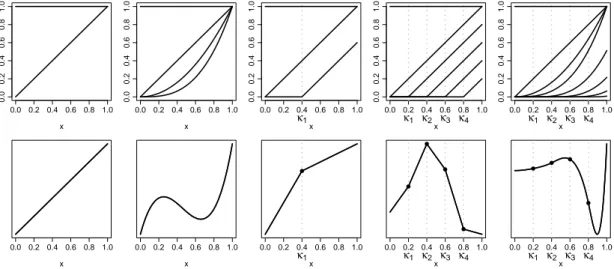
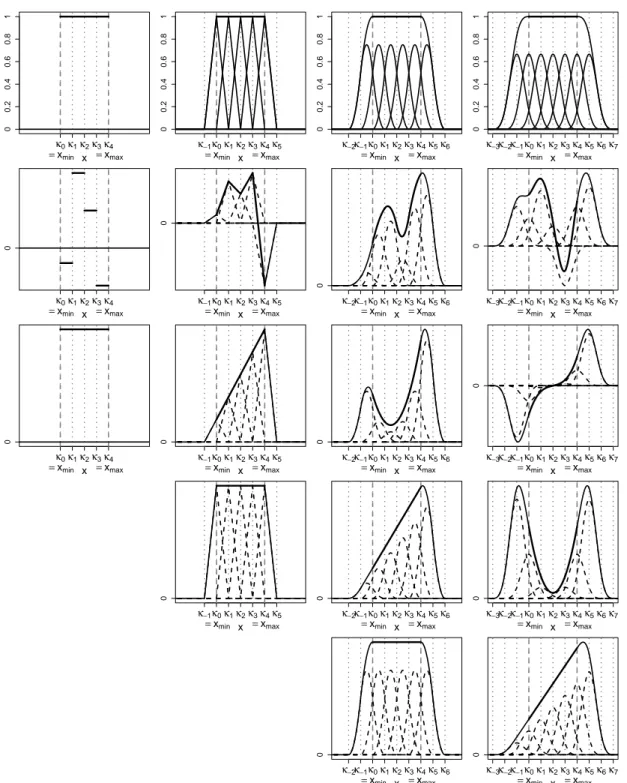
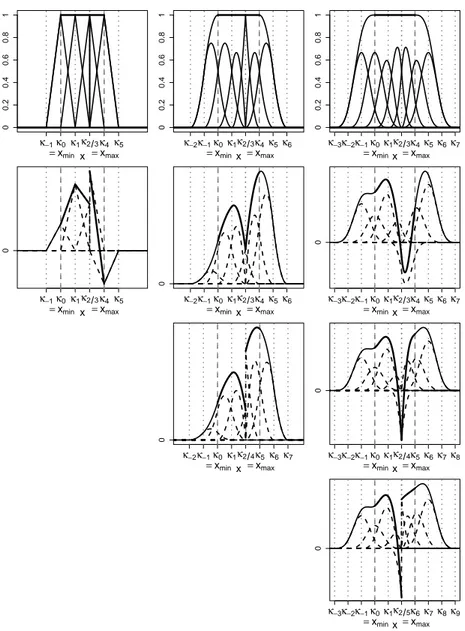
![Figure 1.4: B-spline basis functions of orders 1, 2, 3 and 4 with non-equidistant knots (m = 3), and their sum which is 1 on [ κ 0 , κ m + 1 ] .](https://thumb-eu.123doks.com/thumbv2/1library_info/5634277.1692958/19.892.147.771.139.292/figure-spline-basis-functions-orders-non-equidistant-knots.webp)


